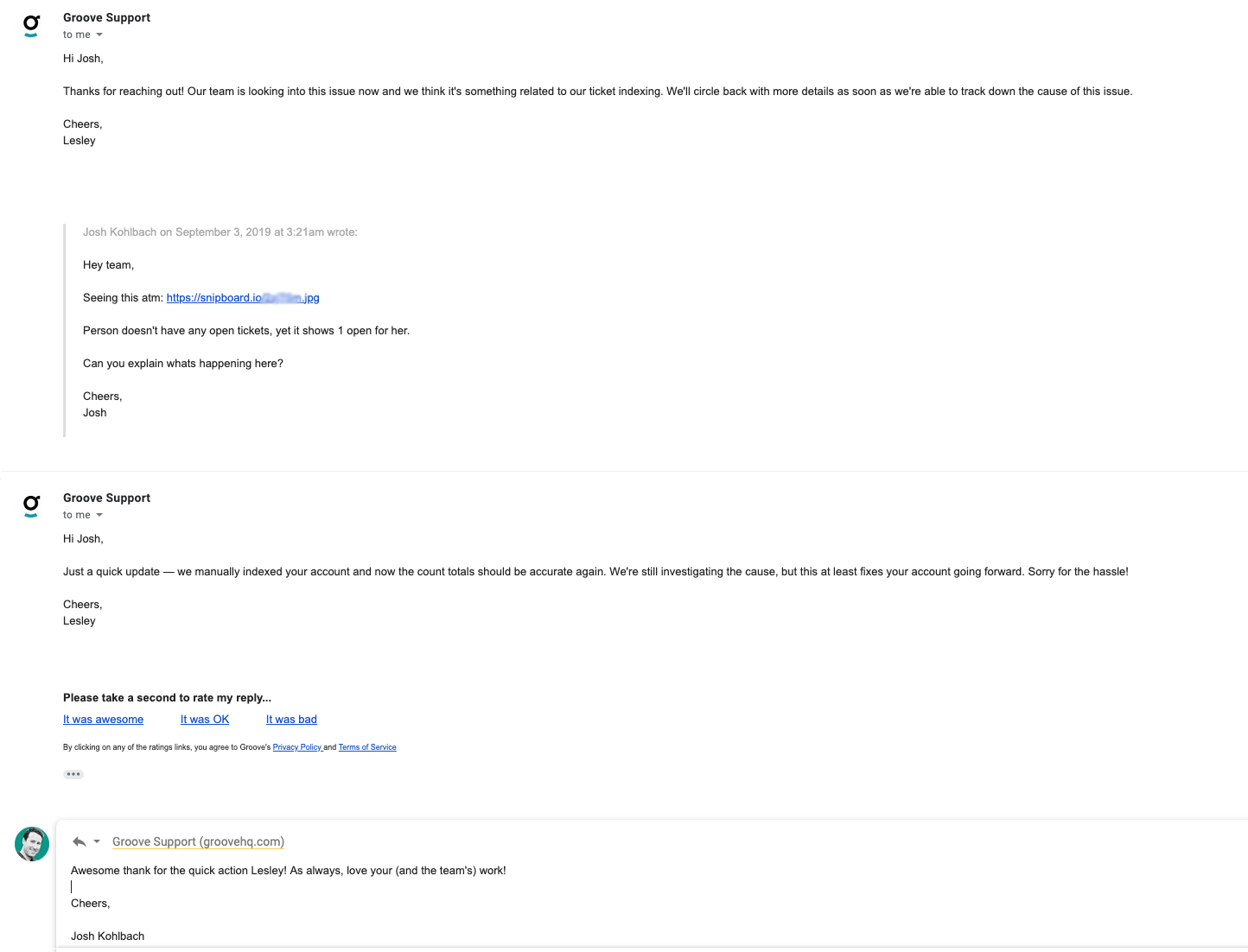
A while back, we surveyed our private store owner community, Store Owner Tips Facebook group, to ask which support tools people used for customer service.
As I said, I used Groove, which received a couple of votes but was not one of the most popular choices.
Groove is like many SaaS companies; it started with a simple offer and nailed its core product execution. Then, it started to grow. Things changed with the lineup over time, and it expanded, which, of course, meant the price had to go up a little bit to cover those costs.
As a software developer, I understand and find it fair and reasonable. However, from a pure accounting perspective, there are cheaper companies out there that provide similar tools.
So why am I still staying with them?
Why would I stay even though the cost is slightly higher?
Why Nailing Your Customer Service Is Important
This screenshot sums up why I have been sticking with them even though price competitiveness tells me I should look at other options.
They stand behind their product and take action when I have a problem. Over the last couple of years, I’ve had multiple similar interactions with Lesley from Groove (as well as their founder, Alex).
The lesson for store owners…
Let’s be real for a second: Customer service isn’t just a “department” or some box you check off.
It’s the heartbeat of your business. It’s how you show people that you’re not just here to sell—you’re here to care. Standing behind your product and showing up for your customers, especially when things go sideways, is what separates the forgettable stores from the ones people rave about.

Whether you hear it or not, people are talking. They’re telling their friends, writing reviews, sharing their experience online, and that becomes your brand’s story. So, if you want that story to be a good one, give them something worth talking about. Deliver the kind of experience that makes someone say, “Damn, they really took care of me.”
However, you won’t make every single customer happy. Some folks just won’t vibe with you, and that’s okay. That’s the cost of putting your stuff out into the world.
But your goal? Make sure the majority walk away feeling heard, helped, and happy. Because when most people walk away with a good feeling, the occasional bad one doesn’t hold much weight.
Customer service isn’t a “nice-to-have.” It’s the part people remember, and it’s what keeps them coming back.
5 Tips For Nailing Your Customer Service
Let’s get into the meat of the article. Now that nailing your customer service is important, how exactly do you do that?
Here are 5 tips I’ve observed that go a long way to delivering an award-winning customer service experience.
1. Be as fast as you can
Speed matters. Like, a lot.
When someone contacts you with a question, whether it’s about shipping, sizing, or whether your product works for left-handed flamingo trainers, they don’t want to wait hours, let alone days, for a reply.
If you’re still taking 24+ hours to get back to people, just know: They’ve probably already bought from someone else who replied in 10 minutes.
Same goes for live chat. If you’ve got that cute little widget sitting in the corner of your site, you better be ready. Because if someone sends a message and hears crickets for over 5 minutes, guess what? They’re gone. The window closed. Sale lost.
Here’s the thing: Don’t use live chat just for show. If you can’t respond quickly, it’s better to remove it than frustrate people.
This is where tools like StoreAgent and Product Questions Agent come into the clutch.
StoreAgent Chat AI
Now, if you’re thinking, “But I can’t be everywhere at once!” — you’re absolutely right. You’re one person, not a call center.
And this is exactly where tools like StoreAgent and its AI Chat shine.
These are smart, AI-powered assistants that speak like your brand and handle real customer questions—the way you would.
You don’t need to drop everything to answer those 15 times daily. StoreAgent Chat AI can handle all that for you on autopilot for you. So, shoppers get instant answers when deciding to buy, not after they’ve bounced.
This means you’re always “on” for your customers even when catching up on sleep, at brunch, or bingeing K-dramas in peace.
Bottom line: These tools save you time, give customers the fast replies they expect, and help you close sales you’d otherwise lose to silence.
You may also read: Online Store AI Tools: How To Enhance Your WordPress Ecommerce Business
2. Solve the problem with as little back and forth as you can
One thing I always watch is how many replies it takes to actually solve something.
Because here’s the deal: Every extra email, every “just following up,” every “let me clarify”—adds friction.
And friction kills good vibes (and sometimes, sales).
So the goal? Make it easy for your customer to get what they need—fast.
Start thinking: “How can I close this loop in one message instead of five?”
A super simple example? Let’s say you’re trying to schedule a time to chat. Instead of asking, “What time works for you this week?” Flip it and give them options: “I’m free Tuesday at 10am, Wednesday at 1pm, or Thursday at 9am. Do any of those work for you?”
No back and forth. Just action.
Now, apply that mindset to customer support. Let’s say you need more information to help someone, like their order number or which product they’re referring to. Don’t just say, “Can you give me your order number?”
Instead, go one step further: “Could you send over your order number? And if you’re asking about a specific item, let me know the product name or color, too. This way I can get everything sorted in one go.”
See how that saves two or three extra replies? That’s the energy. Respect their time and yours.
Fast, clear, and proactive—that’s how you win customer support.
3. If you can’t solve it right away, own it and let them know what you’re doing to get there
Let’s be real—not every issue can be solved in five minutes. Sometimes you need to dig deeper, ask your team, check in with a supplier, or stare at the ceiling for a bit. And that’s totally fine, as long as you communicate.
One thing I appreciated recently? I messaged Groove about an issue, and they said, “I’m not totally sure yet, but I’m going to investigate and keep you posted.” Simple. Human. Clear.
That message alone told me everything I needed to know:
- They got my message.
- They don’t have the answer yet.
- They’re working on it.
- I’m not being ignored.
As a customer, that kind of reply builds instant trust. I’m not left wondering if my email landed in the void or if someone’s actually looking at it. Because silence? Silence feels like being forgotten. And no one wants to feel like that, especially when they’re already dealing with a problem.
So here’s the rule: If you can’t solve it yet, own it. Let them know where you’re at. Be honest, set expectations, and show them you’re on it.
You don’t need all the answers—you just need to show up.
4. Use a good support tool, not your personal email
When I started selling software, I used to provide all the support via my personal email.
When I hired someone to help me with support, I became more formal because I didn’t want to share my personal inbox, which contained sensitive stuff beyond support requests. I had to look for a tool to help me share that support inbox.
I settled on Groove because it was simple, but you can actually use any support management tool. The point is that moving to a professional support system will help you manage your support requests more professionally, which is really important.
I would recommend investing in a system like this as early as possible.
It just ensures that everything gets handled, and you can’t miss something because you have too many emails or accidentally archive something important.
Professionally treat customer support and respect the job by using the right tools.
5. Don’t talk in a professional business-like voice, be personal and real
And lastly, this is something I usually have to beat out of my new support reps when they start, don’t put on a fake ass “professional speak” business-like tone in your emails.
Behind every business, every job, there is a PERSON.
So, talk like a real person, and your interactions will be 1000x better.
Be personal and real. Being casual or informal doesn’t mean being lazy in your writing. I’m not advocating using ‘u’ over ‘you’ or other shorthand text-speak.
It means being casual and seeming like a real person. The best way to describe it is to type like you speak.
What Is Bad Customer Service?
Bad customer service isn’t just someone being rude on the other end of a chat.
- Silence when someone needs help
- Slow replies that leave people hanging
- Vague answers, generic copy-paste responses, or making customers work just to get a solution
It’s when someone reaches out and feels like they’re talking to a wall—or worse, they’re inconveniencing you by asking for help.
Here’s what bad customer service looks like in real life:
- A customer emails you and hasn’t heard back for 3 days.
- They open a live chat and wait 10 minutes with no reply.
- Customer asks a question and gets an answer that wasn’t meant for them.
- They explain a problem, and you ask for the same info twice because you didn’t read their first message.
All of these moments create a feeling of, “They don’t care.” And once a customer feels that? It’s game over.
Because let’s be honest, there are plenty of other stores they can buy from. And if someone else makes them feel heard, helped, and respected? That’s where their money’s going.
Bad customer service isn’t always dramatic. Sometimes it’s just small moments that add up and quietly convince someone not to come back.
How Important Is Customer Service To Your Store?
Short answer? Really important. Long answer? It can literally make or break your business.
Let this stat sink in for a sec:
89% of shoppers have stopped buying from online stores after they’ve experienced poor customer service. – RightNow
That’s not a random opinion; that’s nearly 9 out of 10 people saying, “Yeah, I’m done with this store,” all because of a bad support experience.
It doesn’t matter how good your product is, how cute your packaging looks, or how fierce your Instagram ads are. If the experience falls apart after someone buys, they won’t return. And worse? They’ll tell their friends not to either.
Customer service is your real reputation. It’s the part people remember. The part they talk about. The part that decides whether someone becomes a loyal customer or just a one-time transaction.
So if you’re serious about growing your store, do yourself a favor: Take customer service seriously. Invest in it, prioritize it, and treat it like the core part of your brand that it is.
Frequently Asked Questions
How to provide great customer experience?
Keep it fast, clear, and human. Respond quickly, speak like a real person (not a script), and always try to solve the issue in one message instead of five. Be proactive—answer the next question before they ask it. And if you can’t fix it immediately, let them know you’re working on it and follow up. People remember how you made them feel, not just what you said.
How to improve customer service system?
Start by cleaning up the chaos. Use tools like Product Questions Agent to handle common questions 24/7, and create response templates that actually sound like your brand. Track what matters, like response time and satisfaction, not just how fast you close tickets. Internally, make information easy for your team to find, and treat repeat customer issues as signals that something needs fixing upstream.
How to handle a difficult customer?
Stay calm, don’t take it personally, and let them vent. Acknowledge how they feel and focus on solutions, not blame. Say things like, “I get why you’re upset—let’s fix this,” and keep the conversation moving forward. Set respectful boundaries if needed, and if the fix isn’t possible, close it with grace (and maybe a refund).
Final Thoughts
At the end of the day, customer service isn’t just a feature of your business. It’s why someone comes back, recommends you to their friends, or leaves a glowing review. It’s also the reason they might quietly walk away and never return.
In this article, we also discussed 5 tips for good customer service:
- Be as fast as you can
- Solve the problem in a few messages
- Be honest if you don’t have the answer yet
- Use a good support tool
- Be personal and real
The tools you use, like Product Questions Agent, help make that support fast and consistent, but the intention behind your service matters.
Show up. Communicate like a real human. Make it easy for people to get what they need. You don’t have to be perfect, but you do have to care. That keeps your brand alive in a world full of other options. So if there’s one area of your business to take seriously today, make it this one. Your future self (and your customers) will thank you.






